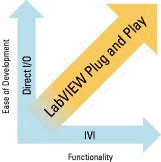Types of Instrument Drivers
Contents
Overview

Plug and Play and Interchangeable Virtual Instrument (IVI) are two technologies used by NI LabVIEW and LabWindows/CVI instrument drivers. Each driver type offers advantages for different use cases and application needs.
Plug and Play
Plug and Play instrument drivers, which simplify control of and communication with your instruments through a standard and straightforward programming model for all drivers, are easier to use and modify than other instrument driver technologies.
A Plug and Play instrument driver is a set of functions used to control and communicate with a programmable instrument. Each function corresponds to a programmatic operation such as configuring, reading from, writing to, and triggering the instrument. Plug and Play instrument drivers comply with programming guidelines. Because Plug and Play drivers maintain a common architecture and interface and include application examples, you can quickly and easily connect to and communicate with your instruments with very little or no code development. Moreover, with the standard programming model of Plug and Play instrument drivers, you can easily add instruments to your test system without worrying about learning new communication protocols or spending time understanding new programming paradigms.
Plug and Play instrument drivers provide source code native to the development environment. With access to source code, you can modify, customize, optimize, debug, and add functionality to the instrument driver. Source code also enables Plug and Play instrument drivers to be cross-platform, so you can use them in any operating system that works with LabVIEW or LabWindows/CVI software.
In addition, Plug and Play instrument drivers that meet NI requirements do not rely on constantly changing technology such as Microsoft technologies. Instead, these instrument drivers are long-term test solutions that have featured compatibility for more than 15 years. With Plug and Play instrument drivers, you can use an instrument driver from 1992 in your test application today instantly with little or no code modification.
NI supports certified Plug and Play instrument drivers.
Plug and Play (project-style)
With the introduction of the LabVIEW 8 Project and the LabVIEW 8 Library, instrument driver developers now can organize functional VIs and example programs directly in the LabVIEW environment. Along with organizational benefits, the LabVIEW Library provides a unique namespace for the instrument driver that automatically adds the instrument driver name to the beginning of every functional VI name. With a unique name for each VI, you no longer need to worry about naming conflicts resulting in broken code. Finally, you also can use the Library to define VIs as either public and accessible to all users or private and usable only by the developer. With the ability to control which VIs are usable, you can maintain a consistent public VI interface while changing the underlying private VIs without fear of breaking the user’s code. Plug and Play (project-style) instrument drivers include all the long-established features of Plug and Play drivers.
NI supports certified Plug and Play (project-style) instrument drivers.
You should continue to use Plug and Play instrument drivers in existing applications created with those drivers. For new projects, use Plug and Play (project-style) instrument drivers to take advantage of the latest LabVIEW features.
Interchangeable Virtual Instrument (IVI)
IVI drivers are more sophisticated instrument drivers that feature increased performance and flexibility for more intricate test applications that require interchangeability, state caching, and/or instrument simulation.
In 1998, NI, along with several other companies, formed the Interchangeable Virtual Instrument Foundation. The IVI Foundation (www.ivifoundation.org) has grown to more than 30 members, including the largest instrument vendors. IVI driver capabilities include state caching and multithreading to deliver higher performance, simulation to increase productivity, and instrument interchangeability to maximize software reuse across similar instrument types. To achieve interchangeability, the IVI Foundation has defined specifications for the following eight instrument classes: digital multimeter, oscilloscope, arbitrary waveform/function generator, DC power supply, switch, power meter, spectrum analyzer, and RF signal generator.
NI IVI drivers deliver performance improvement by integrating a state-caching engine that sends to the instrument only the commands necessary to incrementally change its state. Using an IVI-compliant driver, you can exchange instruments of the same class regardless of manufacturer or bus connection. In addition, IVI drivers can run in simulation mode where no I/O is performed and measurement data is simulated.
If you need interchangeability and simulation in your test applications, IVI drivers provide a flexible tool to save you significant development time and maintenance costs.
NI supports certified IVI instrument drivers.